Text
Conclusion

Fashion has proven itself as one of the most prolific aspects of culture as we know it. This has been the case as long as fashion has been around. So why is so fashion so important to us?
Why do we like fashion?
Fashion is art, but fashion has become as important in culture as it is for its functionality as well. People do not want to be seen naked, it feels vulnerable and embarrassing to show ourselves uncovered so we wear clothes. This is how fashion has become so successful, it's true some people don’t care and for them, plain tee shirts and shorts will do just fine. Those who are inclined towards artistic endeavors however fall in love with the concept of self embellishment. The ability to express oneself is always appealing, fashion gives people a way to do this differently every day. People develop wardrobes that appeal to their personal style which take time and effort to amass. In this way, people wear themselves in their clothing.
Why does fashion like us?

On the other end of things, there's the sheer amount of money in the fashion industry that keeps it thriving. Clothing has become cheaper to produce over time, and people want more than one outfit in their wardrobe. High fashion creates quality pieces and reputations that justify the heightened cost of a product. Along with this, People’s styles change over time. Even if they don't need new clothes, they'll want them. The fashion industry encourages us to buy something new every time a trend goes in or out of style. Fashion is everywhere, from business suits to NBA jerseys, it’s hidden even in the apparel we don’t expect it to be. Fashion even goes beyond clothing, and incorporated into the aesthetic umbrella is hair and makeup. These industries are all incredibly lucrative, creating an abundance of options for consumers to further indulge in.
Fashion and our Culture
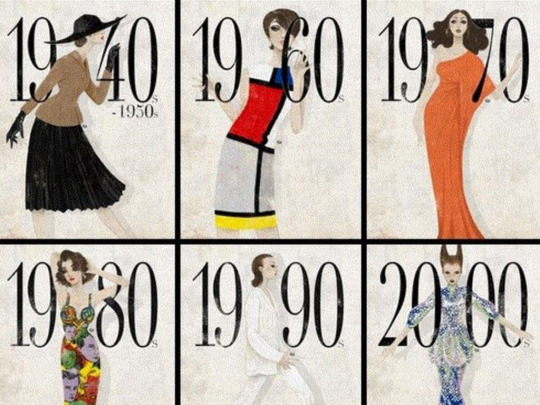
The culture around us influences us further in fashion trends. Movements arise changing the way people view fashion trends. Women’s liberation movements encouraged the normalization of girls wearing pants in the 1920s. Today, we are seeing the normalization of men’s skirts, and further cultural influence on fashion will make way for the adoption of new or past trends in the future. The evolution of emboldened makeup trends is further proof of fashion's evolution coinciding with the evolution of our culture.
Overall, fashion is important to us because it's an expression of oneself. Fashion expresses our insecurities and confidences, our beliefs, and our interests. Inspired by the collective events we see and experience in the world, one’s choice of clothing can share a lot about who they want to be.
0 notes
Text
Dress and the Media

As one of the most influential mediums in the world, fashion has become a pillar in the status, power, and persona of regular and famed people alike. With what status it holds, who gets to decide the trends and innovations of fashion? Who decides what is the popularity of various color schemes, fittings, and styles?
Forefront of Fashion
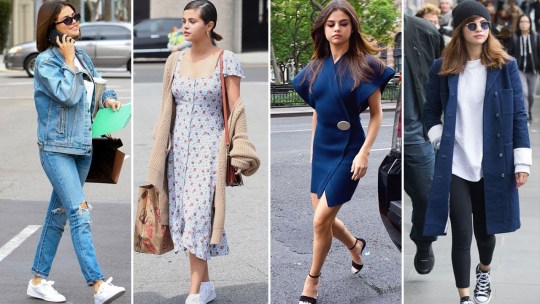
Fashion is a bit different from other mediums as it serves a functional purpose as well. This means there are a few layers regarding who influences where. Influencing general audiences would be celebrities and social media influencers. These people are prominent in media with money to apply towards aesthetics; either in being caught by the pap or in media posted by an artist’s own team brands will collaborate with celebrities sending PR packages in hopes that their pieces will gain notoriety. A notable example of this would be Kanye West’s use of paparazzi to advertise his brand of shoe “Yeezys” “Kanye West knows the power of paparazzi more than most. His choice to publicize the new season collection through staged paparazzi shots of Kardashian West and other celebrity models is in itself a reproduction of the paparazzi’s own work that has made him and his wife rich and powerful.”(Gladman) This method is effective as social media has come to be understood as ‘fake’. Paparazzi gives the illusion of catching what the star is ‘really’ like, making the clothes one wears in these photos to be clothes that were really good.
Behind the scenes

The next layer would be the powers at play above the stars themselves. While famous people decide the next trends to an extent, these people work with teams that help decide what will succeed with audiences. These people come in the form of trend forecasters; trend forecasters use runway shows, fashion magazines, historical trends, and everyday apparel to predict where fashion is headed trend-wise. Once they’ve developed an idea of where fashion looks to be headed, designers use this information to begin drafting designs and pallets. (4 ways) Popular color pallets of the future are predicted by Pantone, though the operation is quite secretive. “One of the most influential committees is a group of 10 people whose names are a secret. They meet in Europe twice a year — May and November — at the invitation of Pantone, a company based in Carlstadt, N.J., whose only business is color.”(Marritz)
Overall, Fashion is broad and complicated. The facets behind what is fashionable are designed in layers, the differing influences on trends have to rely on each other to succeed. With such a refined system, it's difficult to delve fully into the specifics of every important role, but know each role is important in creating fashion.
Sources Cited
“4 Ways the Fashion Industry Chooses Trends.” Daily Front Row, 27 Sept. 2021, fashionweekdaily.com/4-ways-the-fashion-industry-chooses-trends/.
Gladman, Bella. “Why Is Fashion Embracing the Glare of the Paparazzi?” Dazed, 2 Feb. 2018, www.dazeddigital.com/fashion/article/38880/1/why-is-fashion-embracing-the-glare-of-the-paparazzi-yeezy-balenciaga-campaigns.
Marritz, Ilya. “The Business of Color: Company Sets Fashion Trends.” NPR, 10 Feb. 2011, www.npr.org/2011/02/10/133636541/the-business-of-color-company-sets-fashion-trends.
0 notes
Text
Future Fashion and Technology

In the past, fashion has been a luxury afforded by only the wealthiest of our societies. This was because resources were far scarcer, and the technology afforded to us made the production of textiles and garments much more time-consuming. When industrialization allowed for mass production, the fashion industry began to open itself to the global market. Today the fashion industry is massive, fashion has become a luxury affordable to all for a much cheaper price. But with such rapid growth, what can we expect for our future?
3D Technologies
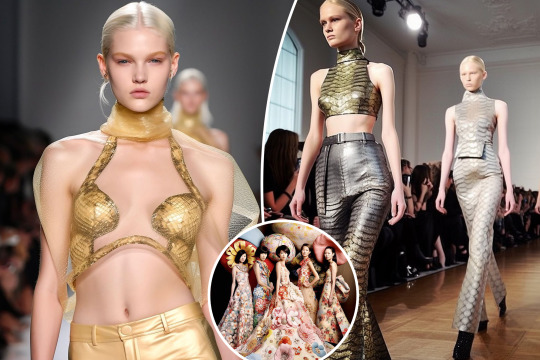
Rapidly developing technology has created a technology that allows for body scanning. “Using captured measurements from a 3D scan, consumers could transmit measurements to online shopping portals, which would then match with appropriate clothing sizes.”(Faster Fashion) This will completely revolutionize fittings, as well as create a user-friendly experience for digital try-on. For example, should someone be looking to purchase a formal dress online, they’d be able to find a style that suits them by having their body scanned and digitized. Once digitized, the clothing may be rendered to fit through an AI program.
AI Refinery

AI will also be useful in optimizing production. Using Open source tech will allow machinery to progressively refine the production process, reducing the risk of factory error. “This includes the use of technologies such as artificial intelligence and machine learning to optimize production processes and supply chains, and the use of blockchain to create transparent and secure supply chains.”(Pittway).
Virtual Reality
Virtual Reality may find a way to integrate itself into fashion. VR has rapidly progressed, popularized originally for gaming, VR quickly became a high-demand item for those interested in augmenting their worlds. Big tech companies have recently revealed their own versions of VR in smart glasses, augmenting your everyday world. Fashion may soon be involving itself in the mix, VR technology allowing one to switch out wardrobes at a whim. “For example, a person may be wearing a white shirt, but when onlookers have glasses on, the clothing may appear to change colour or have an extension only visible through the lens.”(Pittway)
Conclusion
In the end, while we try to predict fashion’s future, no one can truly know the direction it will take. Ultimately we can only hope what is popularized is best for our communities.
Works Cited
“Faster Fashion: Will 3D Body Scans Disrupt Apparel?” Morgan Stanley, www.morganstanley.com/ideas/3d-scanning-apparel#:~:text=Using%20captured%20measurements%20from%20a,body%20image%20of%20the%20consumer. Accessed 17 July 2023.
Pittaway, David. “Future Fashion Trend Predictions What Will Clothes Look like in 100 Years.” Fashion in The Future, 16 May 2023, www.appnova.com/future-fashion-trend-predictions-what-will-clothes-look-like-in-100-years/#:~:text=Extravagant%20Fashion%3A%20Regarding%20the%20clothes,to%20become%20more%203%2DDimensional.
1 note
·
View note
Text
Dress and Status
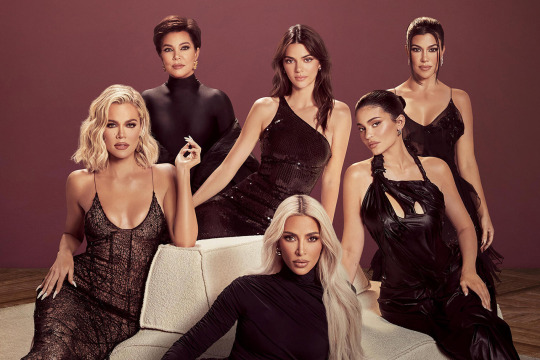
Global emphasis on dress has made it one of the most prolific forms of expression in a modern world. For our societies to function, people created currency to more effectively trade with one another. Wealth has become a very attractive resource to possess, and of course more money means higher quality items. Fashion’s importance in the social threads of society has led to a variety of bizarre standards developing all over the world. So how is one’s status perceived based on dress? The influence of wealth can be seen in a number of ways.
Colorism and Wealth

Because wealth is such an attractive aspect in a person, many social trends develop to directly imitate the wealthy. One such example is colorism within the Asias. “dark skin marked one as a laborer, as a person who toiled in the fields as opposed to one who lived a more sheltered and privileged existence indoors.[...], skin color functioned as an indicator of socioeconomic status.”(Jones) Historically due yellow undertones being common in people of asian descent, their skin could tan to a dark bronze shade under all the sun. As the upper class within Asia didn’t need to work in the fields, wealthy individuals stayed quite pale. The standard preference for lighter skin carries into the modern day, with skin bleaching products remaining incredibly popular within the Asias. This is similar to how European wealth brought from America's encouraged racist notions of other ethnicities most notably those of African descent. Similarly, larger bodies were once considered the most desirable for their indication of wealth for food. As food became commercialized, a slim figure was preferred as larger bodies became associated with fast food.
Celebrity Culture, Fashion, and Economics
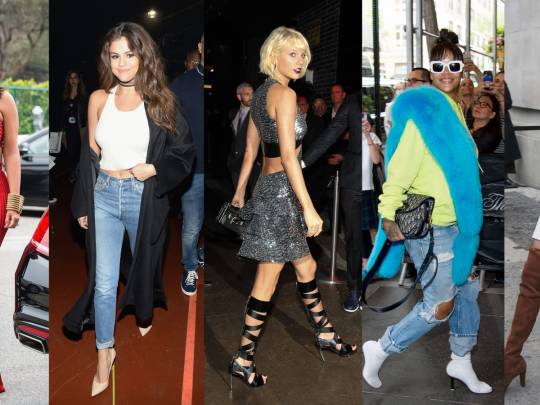
Wealth’s influence on fashion is heavily dependent on the economic state of its society. As the economic crisis impacts civilians, wealth tends to pull away from fashion. The popularization of streetwear was in part due to the economic crisis within America. “Streetwear is one of the most striking retail and fashion trends to have emerged in recent years, [the…] sale and resale of casual fashion – mainly footwear, T-shirts and other items” (Leeb). Street wear’s history within minority communities disadvantaged by historical and modern disadvantages present streetwear as a ‘style for the people’. As the economy within America worsens, sentiment towards billionaires grows very critical as people struggle to survive whilst seeing influencers indulge in overpriced luxury. The same notion goes for their fashion, fashion brands developed luxury streetwear so influencers can still flaunt high end clothes without drawing as much attention to their wealth. Historically this occurred during the great recession in 2008 as well. “the great recession hit-- and peoples' style changed overnight. Many say because it was not ‘cool’ to ‘show off’ their wealth thinking it alluded to you being connected with the mortgage scheme.“(The Cycle)
To conclude, dress and status are intertwined from past to present. As perhaps one of the most influential aspects of fashion for its production, wealth and status continue to shape fashion for the masses to this day.
Works Cited
“The Cycle of Fashion Trends in America’s Depression, Recession and Now Pandemic.” Chosen Womens Apparel, www.chosenapparelboutique.com/blogs/news/the-cycle-of-fashion-trend-in-americas-depression-recession-and-now-pandemic. Accessed 11 July 2023.
Jones, Trina. The Significance of Skin Color in Asian and Asian-American ... - UCI Law, www.law.uci.edu/lawreview/vol3/no4/Jones.pdf. Accessed 11 July 2023.
Leeb, Laura, et al. “Strategy& - the Global Strategy Consulting Team at PWC.” HYPEBEAST, www.strategyand.pwc.com/de/en/industries/consumer-markets/streetwear/streetwear-the-new-exclusivity.pdf. Accessed 11 July 2023.
0 notes
Text
Religion and Ritual in Fashion

While Fashion is commonly used to accentuate one's appearance, the dress we wear can also be used to demonstrate a belief. Typically this is done for a religious belief, religious garments include hijabs, turbans, kippas, and several dozen other articles for varying other religions. Religious and ritual fashion go beyond traditional religious beliefs, many corporations have protocols in place restricting specific appearance modifications for employees. Dress is one of the most influential aspects in identifying a religion, so how does religious dress affect the wearers life? and how do corporations mimic similar notions in dress codes?
What is religious dress?
Religious garbs of dress are symbolic pieces of dress that represent a belief within a certain religion. Head garments are common forms of dress for women as a representation of modesty, “The practice of people wearing head covers and veils for religious purposes is an integral part of all three monotheistic religions (Christianity, Judaism, and Islam), as well as other faiths and cultures. The first records of women wearing head coverings dates back to13th century BC Assyria.”(Religious). Head coverings are used to demonstrate the act of modesty, a virtue in all of the religions mentioned in the quote.
Discrimination against religious dress

Unfortunately, there is a heavy stigmatization within several of these religion’s use of head coverings. Namely Islam and Sikhism, racism against people of middle eastern descent have steadily been on the rise in the western world. “Muslim women and girls have been denied the right to enter public buildings, shopping malls, and swimming pools unless they submit to being searched by male guards or agree to remove their head coverings and other gar-ments that they wear for religious reasons.” (Discrimination). While the nation has become more tolerant of other beliefs, many preconceived notions about people of middle eastern descent were developed. Much of these beliefs developed as a result of 911 and the war in Iraq, but innocent people suffered the backlash of these beliefs.
Corporations take notes
Just like religious groups, corporations have developed dress codes for their employees to follow. Very similarly to religious groups, expectations of employees often include no visible tattoos, dyed hair, unconventional piercings, heavy makeup, or fake acrylics. Interestingly enough, these beliefs align well with the set appearance to be followed in these religions. It’s no coincidence however, corporations create dress codes similar to religious dress codes to ‘put customers at ease’. Because several religions forbid these appearance modifications, society correlates these behaviors with a good moral standing. Corporations see this, and in turn create their code to present employees in a similar light, when customers see someone of ‘good moral character’, they are more likely to trust the employee in what they advertise.
While it's unlikely we will ever see a time where racism has truly disappeared, by educating people on the use of religious clothing articles can make us better equipped to help someone when they are being picked on. In analyzing how corporations create similar dress codes to better sell to its customers, we can better understand religious dress isn't something to be afraid about.
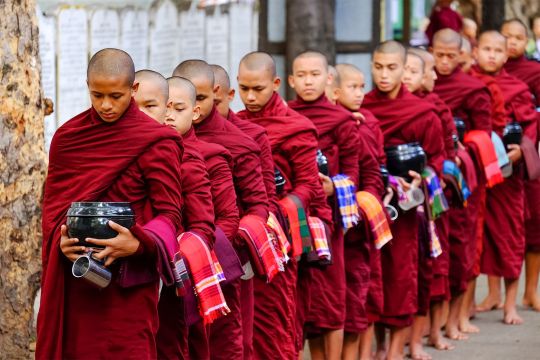
Works Cited
“Discrimination against Muslim Women - Fact Sheet.” American Civil Liberties Union, www.aclu.org/documents/discrimination-against-muslim-women-fact-sheet. Accessed 3 July 2023.
“Religious Head Coverings.” Headcovers Unlimited, www.headcovers.com/resources/hats-scarves/religious-head-coverings/#:~:text=The%20practice%20of%20people%20wearing,back%20to13th%20century%20BC%20Assyria. Accessed 3 July 2023.
0 notes
Text
Race and Ethnicity in Fashion

Fashion is a visual medium of art, so our appearances undeniably play a role in how we interpret a piece or look. Race and ethnicity are quite recognizable aspects of our appearance, and have a long standing history with fashion. Through the good, the bad, and the ugly, how does fashion view race and ethnicity and does ethnicity or race affect interpretations of fashion?
Race And Fashion Historically

Understanding fashion’s relationship with race begins with the historical mistreatment of minority groups. Fashion didn’t begin in America, but America's treatment of African slaves has played a massive part in the development of fashion as we know it. A eurocentric beauty standard was developed, and ethnic features big and small were mocked “the Golden Ratio – a ‘scientific’ measure of ‘universal’ beauty that somehow ranks not a single non-European feature as beautiful”(Sinha). Wide noses, plump lips, curly hair, even looking into the history of body standards; the traditionally ‘beautiful’ body was designed with racist sentiment in mind.
“You know what? When we're in the colonies, we're noticing that Africans are sensuous. They love sex, and they love food. And for this reason, they tend to be too fat. Europeans, we have rational self-control. This is what makes us the premier race of the world. So in terms of body size, we should be slender, and we should watch what we eat.”(Strings) This treatment wasn’t exclusively aimed towards African Americans, features that do not follow a Eurocentric standard would be considered ‘ugly’, and ‘lesser then.’
Race And Fashion Today
Understanding what these standards are and why they exist helps us make sense of how race and ethnicity play a role in fashion. All women are expected to meet societal beauty standards, a feat. that is not realistic for everyone. As the world has globalized and our nation has grown more tolerant, newer standards begin to incorporate ethnic features (exp. plump lips, big hips, and a big bust are now desirable). Still, Eurocentric standards dominate fashion, especially in hair, skin tone, and facial features; the downside of globalization is this standard has globalized with us.
Ethnicity and Fashion

Ethnicity influences our opinions on fashion as we gather opinions from our environment. For example, In East Asian culture it is considered ‘distasteful’ and ‘provocative’ to show any cleavage in public .Tops are made modest, though skirt length is not considered as important. In America, it’s very common to have part of the chest exposed wearing low cut or small tops. So in this case an East Asian woman and an Asian American woman would have different opinions on what is acceptable to wear. Furthermore, ethnicity extends to respect within fashion. Called cultural appropriation, certain dress may be considered distasteful depending on the history behind it. One example is Victoria Secret’s use of a white model and spiritually significant headdress to sell lingerie “during the 2012 show, angels walked the ramp to represent a month of the year and a holiday associated with it. Karlie Kloss walked down the runway wearing a feather headpiece with suede fringe, leopard-print lingerie for November to represent Thanksgiving.”(Srivastava)
As the world globalizes, trends will continue to mesh together, creating new standards of beauty and fashion. It’s important to understand the history of our beauty standards in order to prevent further oppression of any group as well as be willing to discuss our opinions on such matters regardless of view, and to respect the boundaries of certain dress within an ethnicity
Works Cited
Sinha, Lavanya. “Your Standards of Beauty Are Implicitly Eurocentric: A History.” Breakthrough, 27 Sept. 2020, inbreakthrough.org/eurocentric-beauty-history/.
Srivastava, Akarshi. “Cultural Appropriation in Fashion: A Complete Guide.” Shilpa Ahuja, 28 Mar. 2022, shilpaahuja.com/cultural-appropriation-in-fashion/.
String, Sabrina. “Fat Phobia and Its Racist Past and Present.” NPR, 21 July 2020, www.npr.org/transcripts/893006538.
0 notes
Text
Gender Identity and Fashion

Historically, gendered clothing has been the norm for societies. Despite our culture shifting towards one that rebukes the separation of gender through behavior and stereotype, these ideas are deeply ingrained in our culture and are still the standard in many aspects of our daily life- namely clothing. Modern views debate the need for gender societally, but where did these interpretations of gender/sexuality originate from? How did preconceived beliefs manifest itself in the context of fashion? There's a lot to unpack.
Gender Identity in Fashion Historically

To understand why we interpret our clothing the way we do, we must first understand why we associate certain dress with either sex. One such example is the belief of skirts being feminine and trousers being masculine. “For centuries,[1300-1800] female fashion ignored women’s legs and hid them altogether, while women’s arms, busts, or hips were celebrated as erotic zones. Men, in contrast, showed their legs, and for a long period these counted among the male erotic zones.”(Lehnert). Given all fashion’s emphasis on the body, it’s likely we’ve developed our conceived notions of masculinity and femininity in dress based on what is sexually attractive and how to emphasize these features. “[it] has argued from a psychoanalytical perspective that, on the deepest level, all clothing is erotic because beauty derives from sexual sensations and the tension between sexual modesty”(Lehnert).
Gender Identity and Sexuality: Normative
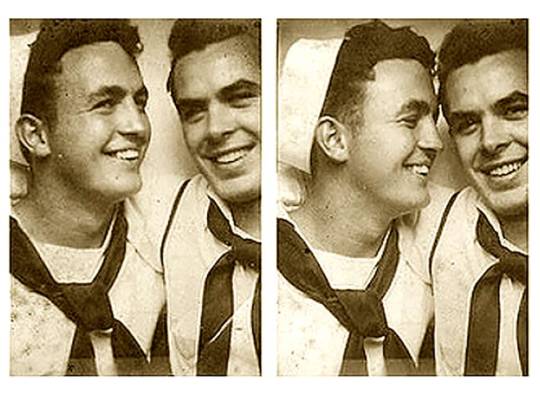
Assuming clothing is gendered based on sexual attraction, we can explore how these norms have developed into varying fashions to express sexuality and the evolving scope of gender. Expressions of varying sexualities have been done through a multitude of ways, earlier expressions of homosexuality presented normative; one such example of this was the prominence of sailors as a heavily fetishized concept for the gay community during the early to mid 1900s. “Soldiers and sailors had had an erotic appeal for gay men throughout the twentieth century, as one man’s reminiscences of sailors’ uniforms during the 1920s indicates: ‘It was very flattering, quite unlike the uniform of recent times. The neck of their tunic was cut in a very rough square, which gave the wearer a very masculine appeal… The trousers must have been made to titillate. They were very tight around the waist and bottoms, but baggy around the ankles. If the sailor wore no underwear then very little was left to the imagination.’"(Cole).
Gender Identity and Sexuality: Subversive
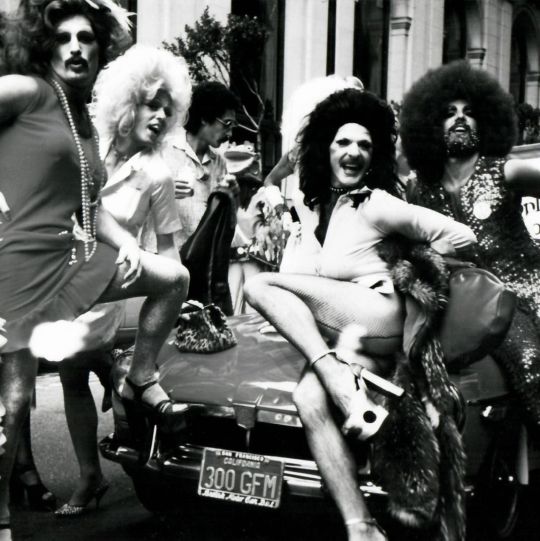
Subversive trends within sexuality began to take off with the arrival of punk in the 70’s. “The New York Dolls’ style of dress at this point was heavily influenced by the ‘two most famous downtown drag queens’ and cohorts of Andy Warhol, Jackie Curtis and Candy Darling. Jayne County describes Jackie Curtis as ‘a hip drag queen, [who] took everything to extremes. She walked around in ripped stockings and big tears in her dresses with threads hanging off…’”(Cole) The style’s destructive aesthetic allowed a revealing look that would lead to the club scene fashion of the 80’s, where skin, mesh, and layering were all the rage.
As our world rapidly modernizes and globalizes, the concept of gender has become controversial; creating a gray area of fashion for sexuality. It’s likely fashion will continue towards louder, less traditional styles, seeing how sexuality and gender’s role in the future will play heavily into our dress and trends alike.
Works Cited
Cole, Shaun. "Express Yourself: Clubbing at the Blitz, the Batcave, and Beyond", in ‘Don We Now Our Gay Apparel’: Gay Men’s Dress in the Twentieth Century. Oxford: Berg, 2000. 157–168. Dress, Body, Culture. Bloomsbury Fashion Central. Web. 16 Nov. 2020.
Lehnert, Gertrud. "Gender." Berg Encyclopedia of World Dress and Fashion: West Europe. Ed. Lise Skov. Oxford: Berg, 2010. 452–461. Bloomsbury Fashion Central. Web. 16 Nov. 2020.
1 note
·
View note
Text
Body and Fashion: Understanding Ideals

Human beings are particularly concerned with their appearances. Spending thousands on the beauty industry yearly on our face, hair, and bodies. With so much emphasis on how we look, it's unsurprising our fashion is heavily dependent on our bodies and flattering them- so how is it that fashions vary so much cross-culturally? It's because different cultures have adopted a variety of beauty standards for the body as well as customs based in important cultural practices (religion, region, tradition).
Ideals Men and Women

Understanding the ‘ideal’ body types for both men and women helps us identify why cultural standards exist. For women, there exists the concept of ‘the feminine beauty ideal’. ”The feminine beauty ideal is a specific set of beauty standards regarding traits that are ingrained in women throughout their lives and from a young age to increase their perceived physical attractiveness. [...] The feminine beauty ideal traits include but are not limited to: female body shape, facial feature, skin tones, height, clothing style, hairstyle and body weight.”(Spade). For women, this standard tries to demonstrate youth and fertility, typically ideal figures being ‘coke bottle’ or ‘hourglass’. “heterosexual evolutionary perspective suggests that men, over time and across cultures, prefer youthful features (smooth skin, white eyes, full lips, good muscle tone, leg length, lumbar curvature, facial symmetry, long/full hair, feminine voice) as indications of fertility or healthy genes.”(Wenzlaff) For men, the antithesis being true through the Masculine beauty ideal “The masculine beauty ideal traits include but are not limited to: male body shape, height, skin tones, body weight, muscle mass, and genital size.”(Hames) Notably these standards are rooted in heteronormative beliefs, but still influence men and women regardless of sexuality/ gender identity.
Ideals Historical and Modern

With a general standard for men and women established, historically differing body standards are typically a result of status, wealth, and beliefs. “Based on Roman art and literature, small breasts and wide hips were the ideal body type for women considered alluring by Roman men.”(Kelly).Softer, fleshy bodies were ideal In this culture due to indication of wealth. Womens’ breasts were primarily seen as food for infants. As a result, larger breasts were seen as undesirable, and of ‘old age’. In modern day Italy the standard has completely flipped. “In Italy, slender women with medium to large breasts and narrow hips are considered the most beautiful.”, a standard resulting from a globalizing world. This demonstrates the fluidity of standards, constantly changing as a result of the environment presented to us.
Ideals Culture to Culture
We can further see the fluidity of these standards in modern cultures. Take for example standards for men of Peru vs. men of South Korea. Peruvian men embrace masculinity as the most important physical attribute, focusing on strength and rejecting traditionally feminine characteristics. “According to the men interviewed, a male should not wear any adornments that look feminine. Therefore, makeup is out of the question for males because it feminizes them..”(Fuller) This as opposed to the androgenized ideal of south korea where men are encouraged to groom themselves in traditionally more feminine ways “the men use foundation and lip gloss, pluck their eyebrows, wear longish, wavy hairstyles…”(Maliangkay).
So through understanding the cultural emphasis we put on our bodies, we will be able to better explore why certain fashions exist across different cultures and how they come to be.
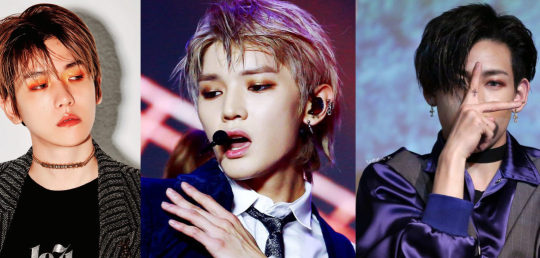
Works Cited
Fuller, Norma. “Peruvian Beauty.” ReVista, 10 Jan. 2017, revista.drclas.harvard.edu/peruvian-beauty/.
Hames, R. "Beauty" (PDF). University of Nebraska - Lincoln. Retrieved 15 December 2022.
Kelly Olson, "The Appearance of the Young Roman Girl," in Roman Dress and the Fabrics of Roman Culture (University of Toronto Press, 2008)
Maliangkay, Roald. “International Institute for Asian Studies.” The Effeminacy of Male Beauty in Korea, 2010, www.iias.asia/sites/default/files/nwl_article/2019-05/IIAS_NL55_0607.pdf.
Spade, Joan Z; Valentine, Catherine (Kay) G (2010). The Kaleidoscope of Gender: Prisms, Patterns and Possibilities (3rd ed.). SAGE Publications, Inc. ISBN 978-1412979061.
Wenzlaff, Frederike; Briken, Peer; Dekker, Arne (2018-03-01). Pellis, Sergio (ed.). "If there's a penis, it's most likely a man: Investigating the social construction of gender using eye tracking". PLOS ONE. 13 (3): e0193616. Bibcode:2018PLoSO..1393616W. doi:10.1371/journal.pone.0193616. ISSN 1932-6203. PMC 5832313. PMID 29494689.
0 notes
Text
Introduction: Fashion and Globalization
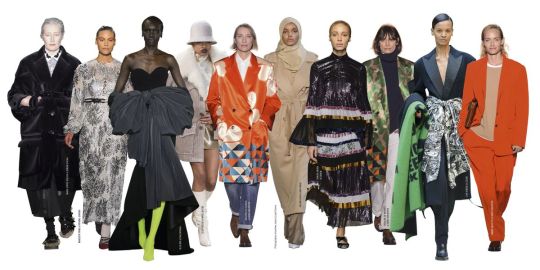
Throughout time, humanity has changed and adapted as a response to all things big and small; The significance of dress to humans means fashion follows. While it's impossible to determine all of the influences fashion has been shaped by throughout its history, it's clear that culture is the most recognizable and influential. Enter globalization; a concept that both unifies and divides culturally, but how is that possible?
Consider the two opposing views on globalization
Globalization is important in understanding people of different cultures through exposure allowing for “better understanding of foreign values and attitudes. Less stereotyping and fewer misconceptions about other people and cultures”("Globalization Pros and Cons") Still, the loss and exploitation of cultures around us and power imbalance among nations is undeniably a problem due to globalization. ”The loss of traditions associated with globalization is cultural imperialism. For example, the Maasai, an ethnic group in East Africa, are historically pastoral and semi-nomadic. Throughout the past century, many Maasai have transitioned to farming or other occupations besides their traditional lifestyle.”(Garbuio) Perhaps we should aim to find a middle ground; to share cultures worldwide but with emphasis on respect towards the separate origins of the practices, art, and characteristics being shared. This means respecting the sacristy of certain practices towards a culture and knowing when and if participation would be respectful.
Globalization and Cultural Authentication
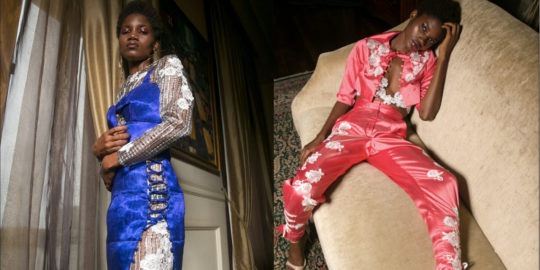
With an understanding in mind of globalization and its effects on culture comes the question of its relation to cultural authentication. While it’s arguable cultural authentication promotes globalization, a bigger case can be made for globalization’s prompting of cultural authentication. As we globalize, our lines of communication grow faster and more efficiently, allowing contact between people of cultures who wouldn’t have been able to interact with one another prior. “As more cultures have cross-cultural contact, people begin to change aspects of their cultures by incorporating aspects of different cultures they come into contact with.”(Elder). An example of this is globalization through immigration and economics between China and Africa. “As the Chinese population in Africa continues to increase along with China’s large economic involvement in Africa’s economy, local African dress styles are absorbing elements of Chinese culture to produce a novel and individualistic Sino-African look”(Liu).
Studying Globalized fashion
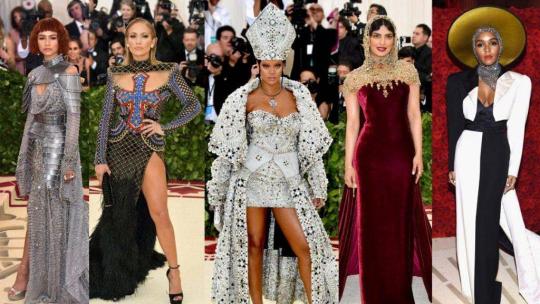
Knowing the advantages and disadvantages of globalization culturally, we can see advantages and setbacks of studying fashion through a global lens. There's benefit in studying cultural fashion on a global scale; it allows a better understanding of our textile, silhouette origins, and pattern usage in conjunction with culture. If respected, diversity can be incorporated into fashion, concerns arise when little care is taken to credit the origins. “The ministry said the companies had taken inspiration from designs created in the south-western state of Oaxaca and called for benefits to be awarded to the communities behind them.”(Marriott). There’s incredible beauty in sharing our ways of life with each other, but we can’t lose sight of the history and significance of our original cultures. Through acknowledgment we find respect, and it is through respect that humanity may continue to grow.
Sources Cited
Elder, Abbey K., et al. “Culture.” Dress Appearance and Diversity in US Society, 1 Aug. 2020, iastate.pressbooks.pub/dressappearancediversity/chapter/culture/#:~:text=As%20more%20cultures%20have%20cross,referred%20to%20as%20cultural%20authentication.
Garbuio, Caleb, and Ella Adams. “Opinion: Big Business Is Killing Cultures.” The Appalachian, 12 Feb. 2021, theappalachianonline.com/opinion-big-business-is-killing-cultures/#:~:text=The%20loss%20of%20traditions%20associated,occupations%20besides%20their%20traditional%20lifestyle.
“Globalization Pros and Cons: Economic, Cultural, Political.” Netivist.Org, netivist.org/debate/globalization-pros-and-cons-economic-cultural-and-political. Accessed 5 June 2023.
Liu, Si Ting (Jess). “The Authentication of Chinese Culture in African Fashion.” Fashion History Timeline, 16 July 2021, fashionhistory.fitnyc.edu/chinese-culture-in-african-fashion/.
Marriott, Hannah. “Mexico Accuses Zara and Anthropologie of Cultural Appropriation.” The Guardian, 1 June 2021, www.theguardian.com/fashion/2021/jun/01/mexico-accuses-zara-and-anthropologie-of-cultural-appropriation.
2 notes
·
View notes